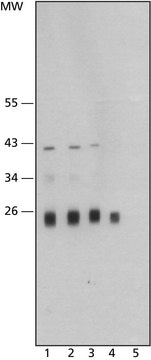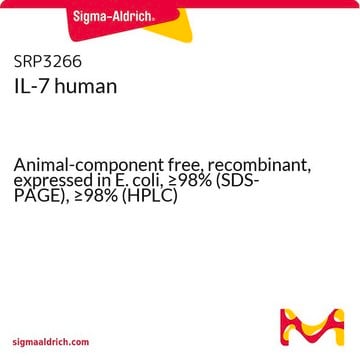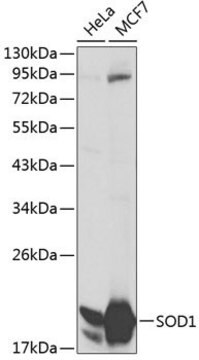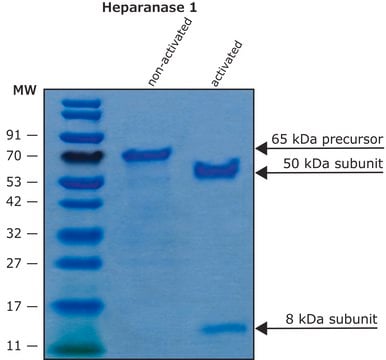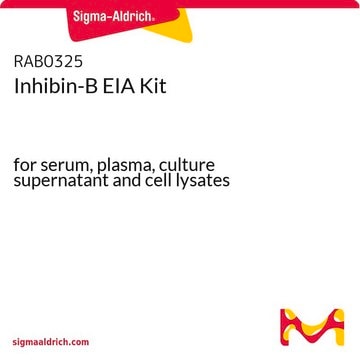General description
Heparanase (UniProt: Q9Y251; also known as EC: 3.2.1.166, Endo-glucuronidase, Heparanase-1, Hpa1) is encoded by the HPSE (also known as HEP, HPA, HPA1, HPR1, HPSE1, HSE1) gene (Gene ID: 10855) in human. Heparanase is a heterodimeric, glycosylated, endoglycosidase that cleaves heparan sulfate proteoglycans (HSPGs) into heparan sulfate side chains and core proteoglycans and participates in extracellular matrix (ECM) degradation and remodeling. It is known to selectively cleave the linkage between a glucuronic acid unit and an N-sulfo glucosamine unit carrying either a 3-O-sulfo or a 6-O-sulfo group. It is also shown to cleave the linkage between a glucuronic acid unit and an N-sulfo glucosamine unit carrying a 2-O-sulfo group, but not linkages between a glucuronic acid unit and a 2-O-sulfated iduronic acid moiety. Heparanase is highly expressed in placenta and spleen and weakly expressed in lymph node, thymus, peripheral blood leukocytes, bone marrow, endothelial cells, fetal liver, and tumor tissues. Heparanase is synthesized with a signal peptide (aa 1-35) and a propeptide chain (110-157), which are cleaved off to produce the heterodimeric mature form of 8 kDa and 50 kDa subunits. This active 8/50 kDa heterodimer is resistant to degradation. Heparanase is essentially inactive at neutral pH but becomes active under acidic conditions such as during tumor invasion and in inflammatory processes. Heparanase activity is inhibited by EDTA and laminarian sulfate. Four isoforms of heparanase have been described that are produced by alternative splicing.
Specificity
This rabbit polyclonal antibody detects human Heparanase-1. It targets an epitope with in 13 amino acids from the C-terminal half of larger subunit (50 kDa).
Immunogen
KLH-conjugated linear peptide corresponding to 13 amino acids from the C-terminal half of larger subunit (50 kDa)of human Heparanase-1.
Application
Anti-Heparanase-1, Cat. No. ABC1687, is a rabbit polyclonal antibody that detects Heparanase-1 and has been tested for use in Immunohistochemistry (Paraffin) and Western Blotting.
Immunohistochemistry (Paraffin) Analysis: A 1:50 dilution from a representative lot detected Heparanase-1 in human spleen and human placenta tissue sections.
Western Blotting Analysis: 1 µg/mL from a representative lot detected Heparanase-1 in human spleen tissue lysate.
Research Category
Apoptosis & Cancer
Quality
Evaluated by Western Blotting in NIH/3T3 cell lysate.
Western Blotting Analysis: 1 µg/mL of this antibody detected Heparanase-1 in NIH/3T3 cell lysate.
Target description
~59 kDa observed; 61.15 kDa calculated. Uncharacterized bands may be observed in some lysate(s).
Physical form
Affinity Purified
Purified rabbit polyclonal antibody in buffer containing 0.1 M Tris-Glycine (pH 7.4), 150 mM NaCl with 0.05% sodium azide.
Storage and Stability
Stable for 1 year at 2-8°C from date of receipt.
Other Notes
Concentration: Please refer to lot specific datasheet.
Disclaimer
Unless otherwise stated in our catalog or other company documentation accompanying the product(s), our products are intended for research use only and are not to be used for any other purpose, which includes but is not limited to, unauthorized commercial uses, in vitro diagnostic uses, ex vivo or in vivo therapeutic uses or any type of consumption or application to humans or animals.
